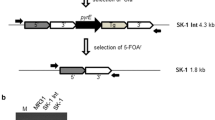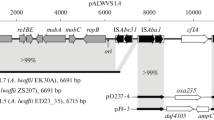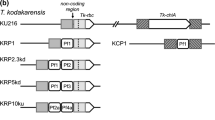Summary
Growth in a chemostat of the 3-chlorobenzoatepositive Pseudomonas putida cells harboring the plasmid pAC25, in presence of cells harboring the TOL plasmid, allows emergence of cells that can also utilize 4-chlorobenzoate (4Cba). Isolation of plasmid DNA from such cells demonstrate the deletion of a 11kb (Kilobase pair) EcoR1 fragment from the pAC25 plasmid; a portion of the TOL plasmid (41.5 kb TOL*) is also found to be transposed onto the chromosome of such cells. Further enrichment of the 4-chlorobenzoate-positive cells with 3,5-dichlorobenzoate (3,5-Dcb) as a sole carbon source has produced cells that can also slowly utilize 3,5-dichlorobenzoate. Isolation of plasmid DNA from such cells demonstrates the appearance of a second plasmid (pAC29). Restriction hybridization of pAC29 EcoRI fragments with pAC25 and TOL demonstrates that pAC29 is derived primarily by duplication of a segment of the pAC27 plasmid and a fragment from TOL, with further mutational divergence. Southern hybridization of the EcoRI-digested chromosomal DNA with 32P-labeled TOL, pTS11 and pTS71 plasmid DNAs demonstrates the presence of the TOL* transposon containing xylD, G, E and F genes in both 4Cba+ (pAC27+) and 3,5-DCb+ (pAC27+, pAC29+) cells. Isolation of plasmid DNA from 3,5-Dcb+ faster growing variants, obtained from slow-growing pAC27+ pAC29+ cells, demonstrates the presence of a single type of plasmid, with identical size and EcoRI digestion profile as pAC27. The implications of gene duplications and subsequent homologous recombination with regard to the biochemical pathway of 3,5-dichlorobenzoate degradation have been discussed.
Similar content being viewed by others
References
Chakrabarty AM, Friello DA, Bopp LH (1979) Transposition of plasmid DNA segments specifying hydrocarbon degradation and their expression in various microorganisms. Proc Natl Acad Sci USA 75:3109–3112
Chatterjee DK, Kellogg ST, Hamada S, Chakrabarty AM (1981a) Plasmid specifying total degradation of 3-chlorobenzoate by a modified ortho pathway. J Bacteriol 146:639–646
Chatterjee DK, Kellogg ST, Watkins DR, Chakrabarty AM (1981b) Plasmids in the biodegradation of chlorinated aromatic compounds. In: Levy S, Clowes RC, Koenig E (eds) Molecular biology, pathogenicity and ecology of bacterial plasmids. Plenum Press, New York, pp 519–528
Dorn E, Hellwig M, Reineke W, Knackmuss H-J (1974) Isolation and characterization of a 3-chlorobenzoate degrading pseudomonad. Arch Microbiol 99:61–70
Evans WC, Smith BSW, Moss P, Fernley HN (1971) Bacterial metabolism of 4-chlorophenoxyacetate. Biochem J 122: 509–517
Hartmann J, Reineke W, Knackmuss H-J (1979) Metabolism of 3-chloro-, 4-chloro-, and 3,5-dichlorobenzoate by a pseudomonad. Appl Environ Microbiol 37:421–428
Hainaru AL, Duggleby JC, Broda P (1978) Molecular relationships of degradative plasmids determined by in situ hybridization of their endonuclease-generated fragments. Mol Gen Genet 160:347–351
Inouye S, Nakazawa A, Nakazawa T (1981) Molecular cloning of gene XylS of the TOL plasmid: Evidence for positive regulation of the XylDEGF operon by XylS. J Bacteriol 148:413–418
Jacoby GA, Shapiro JA (1977) Plasmids studied in Pseudomonas aeruginosa and other pseudomonads. In: Bukhari AI, Shapiro JA, Adhya S (eds) DNA insertion elements, plasmids, and episomes. Cold Spring Harbor Laboratory, New York, pp 639–656
Jacoby GA, Rogers JE, Jacob AE, Hedges RW (1978) Transposition of Pseudomonas toleuene-degrading genes and expression in E. coli. Nature 274:179–180
Jeenes DJ, Williams PA (1982) Excision and integration of degradative pathway genes from TOL plasmid pWWO. J Bacteriol 150:188–194
Klecka GM, Gibson DT (1981) Inhibition of catechol 2,3-dioxygenase from Pseudomonas putida by 3-chlorocatechol. Appl Environ Microbiol 41:1159–1165
Maniatis T, Jeffrey A, Kleid DG (1975) Nucleotide sequence of rightward operator of phage λ. Proc Natl Acad Sci USA 72:1184–1188
Reineke W, Knackmuss H-J (1980) Hybrid pathway for chlorobenzoate metabolism in Pseudonomas sp. 813 derivatives. J Bacteriol 142:467–473
Rosenberg A, Alexander M (1980) Microbial metabolism of 2,4,5-trichlorophenoxyacetic acid in soil, soil suspension and axenic culture. J Agric Food Chem 28:297–302
Southern EM (1975) Detection of specific sequences among DNA fragments separated by gel electrophoresis. J Mol Biol 98:503–517
Author information
Authors and Affiliations
Additional information
Communicated by H.W. Boyer
Rights and permissions
About this article
Cite this article
Chatterjee, D.K., Chakrabarty, A.M. Genetic rearrangements in plasmids specifying total degradation of chlorinated benzoic acids. Mol Gen Genet 188, 279–285 (1982). https://doi.org/10.1007/BF00332688
Received:
Issue Date:
DOI: https://doi.org/10.1007/BF00332688




